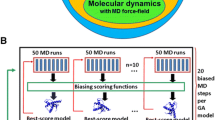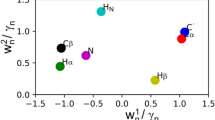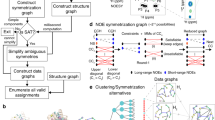Abstract
Data validation plays an important role in ensuring the reliability and reproducibility of studies. NMR investigations of the functional properties, dynamics, chemical kinetics, and structures of proteins depend critically on the correctness of chemical shift assignments. We present a novel probabilistic method named ARECA for validating chemical shift assignments that relies on the nuclear Overhauser effect data . ARECA has been evaluated through its application to 26 case studies and has been shown to be complementary to, and usually more reliable than, approaches based on chemical shift databases. ARECA is available online at http://areca.nmrfam.wisc.edu/.






Similar content being viewed by others
References
Baldwin AJ, Kay LE (2009) NMR spectroscopy brings invisible protein states into focus. Nat Chem Biol 5:808–814
Berman H, Henrick K, Nakamura H, Markley JL (2007) The worldwide Protein Data Bank (wwPDB): ensuring a single, uniform archive of PDB data. Nucleic Acids Res 35:D301–D303
Buchner L, Güntert P (2015) Increased reliability of nuclear magnetic resonance protein structures by consensus structure bundles. Structure 23:425–434
Goldflam M, Tarrago T, Gairi M, Giralt E (2011) NMR studies of protein-ligand interactions. Methods Mol Biol 831:233–259
Huang YJ, Powers R, Montelione GT (2005) Protein NMR recall, precision, and F-measure scores (RPF Scores): structure quality assessment measures based on information retrieval statistics. JACS 127:1665–1674
Kim JH, Tonelli M, Markley JL (2012) Disordered form of the scaffold protein IscU is the substrate for iron-sulfur cluster assembly on cysteine desulfurase. PNAS 109:454–459
Kleckner IR, Foster MP (2011) An introduction to NMR-based approaches for measuring protein dynamics. Biochim Biophys Acta 1814:942–968
Kundrot CE, Ponder JW, Richards FM (1991) Algorithms for calculating excluded volume and its derivatives as a function of molecular conformation and their use in energy minimization. J Comput Chem 12:402–409
Lee W, Yu W, Kim S, et al (2012) PACSY, a relational database management system for protein structure and chemical shift analysis. J Biomol NMR 54:169–179. doi:10.1007/s10858-012-9660-3
Lee W, Stark JL, Markley JL (2014) PONDEROSA-C/S: client-server based software package for automated protein 3D structure determination. J Biomol NMR 60:73–75
Lee W, Tonelli M, Markley JL (2015) NMRFAM-SPARKY: enhanced software for biomolecular NMR spectroscopy. Bioinformatics 31:1325–1327
Moseley HN, Sahota G, Montelione GT (2004) Assignment validation software suite for the evaluation and presentation of protein resonance assignment data. J Biomol NMR 28:341–355
Nishida N, Shimada I (2011) An NMR method to study protein-protein interactions. Methods Mol Biol 757:129–137
Pappu RV, Hart RK, Ponder JW (1998) Analysis and application of potential energy smoothing and search methods for global optimization. J Phys Chem B 102:9725–9742
Ponder JW, Richards FM (1987) An efficient newton-like method for molecular mechanics energy minimization of large molecules. J Comput Chem 8:1016–1024
Ponder JW, Wu C, Ren P, Pande VS, Chodera JD, Schnieders MJ, Haque I, Mobley DL, Lambrecht DS, DiStasio RA Jr, Head-Gordon M, Clark GN, Johnson ME, Head-Gordon T (2010) Current status of the AMOEBA polarizable force field. J Phys Chem B 114:2549–2564
Ren P, Ponder JW (2003) Polarizable atomic multipole water model for molecular mechanics simulation. J Phys Chem B 107:5933–5947
Ren P, Wu C, Ponder JW (2011) Polarizable atomic multipole-based molecular mechanics for organic molecules. J Chem Theory Comput 7:3143–3161
Rieping W, Vranken WF (2010) Validation of archived chemical shifts through atomic coordinates. Proteins 78:2482–2489
Rosato A, Vranken W, Fogh R, Ragan T, Tejero R, Pederson K, Lee H-W, Prestegard J, Yee A, Wu B, Lemak A, Houliston S, Arrowsmith C, Kennedy M, Acton T, Xiao R, Liu G, Montelione G, Vuister G (2015) The second round of critical assessment of automated structure determination of proteins by NMR: CASD-NMR-2013. J Biomol NMR 62:413–424
Schmidt E, Güntert P (2012) A new algorithm for reliable and general NMR resonance assignment. J Am Chem Soc 134:12817–12829
Serrano P, Pedrini B, Mohanty B, Geralt M, Herrmann T, Wuthrich K (2012) The J-UNIO protocol for automated protein structure determination by NMR in solution. J Biomol NMR 53:341–354
Shen Y, Bax A (2007) Protein backbone chemical shifts predicted from searching a database for torsion angle and sequence homology. J Biomol NMR 38:289–302
Shen Y, Bax A (2010) SPARTA+: a modest improvement in empirical NMR chemical shift prediction by means of an artificial neural network. J Biomol NMR 48:13–22
Shen Y, Bax A (2013) Protein backbone and sidechain torsion angles predicted from NMR chemical shifts using artificial neural networks. J Biomol NMR 56:227–241
Ulrich EL, Akutsu H, Doreleijers JF, Harano Y, Ioannidis YE, Lin J, Livny M, Mading S, Maziuk D, Miller Z, Nakatani E, Schulte CF, Tolmie DE, Kent Wenger R, Yao H, Markley JL (2008) BioMagResBank. Nucleic Acids Res 36:402–408
Vernet RD, Boekelheide V (1974) Nuclear magnetic resonance spectroscopy. ring-current effects on carbon-13 chemical shifts. PNAS 71:2961–2964
Vranken WF, Rieping W (2009) Relationship between chemical shift value and accessible surface area for all amino acid atoms. BMC Struct Biol 9:20
Wang L, Eghbalnia HR, Bahrami A, Markley JL (2005) Linear analysis of carbon-13 chemical shift differences and its application to the detection and correction of errors in referencing and spin system identifications. J Biomol NMR 32:13–22
Wang B, Wang Y, Wishart DS (2010) A probabilistic approach for validating protein NMR chemical shift assignments. J Biomol NMR 47:85–99
Wannere CS, Schleyer PV (2003) How do ring currents affect (1)h NMR chemical shifts? Org Lett 5:605–608
Wassenaar T, van Dijk M, Loureiro-Ferreira N, van der Schot G, de Vries S, Schmitz C, van der Zwan J, Boelens R, Giachetti A, Ferella L, Rosato A, Bertini I, Herrmann T, Jonker HA, Bagaria A, Jaravine V, Güntert P, Schwalbe H, Vranken W, Doreleijers J, Vriend G, Vuister G, Franke D, Kikhney A, Svergun D, Fogh R, Ionides J, Laue E, Spronk C, Jurkša S, Verlato M, Badoer S, Dal Pra S, Mazzucato M, Frizziero E, Bonvin AJJ (2012) WeNMR: structural biology on the grid. J Grid Comput 10:743–767
Wüthrich K (1986) NMR of proteins and nucleic acids. Wiley, Hoboken
Xu Y, Zheng Y, Yang D (2006) NOESY-based strategy for assignments of backbone and side chain resonances of large proteins without deuteration. Nat Protoc Exch. doi:10.1038/nprot.2006.410
Yao L, Grishaev A, Cornilescu G, Bax A (2010) The impact of hydrogen bonding on amide 1H NMR spectroscopy. JACS 132:10866–10875
Zhang H, Neal S, Wishart DS (2003) RefDB: a database of uniformly referenced protein chemical shifts. J Biomol NMR 25:173–195
Acknowledgments
HD thanks Alireza Siahpirani (Wisconsin Institute of Discovery) for invaluable discussions about the computational aspects of the introduced method and Dr. Vincent Chen (National Magnetic Resonance Facility at Madison) for helpful discussions concerning applications of the MolProbity program. For the use of web portals, computing and storage facilities, we thank the WeNMR project (European FP7 e-Infrastructure grant, contract no. 261572, www.wenmr.eu), supported by the European Grid Initiative (EGI) through the national GRID Initiatives of Belgium, France, Italy, Germany, the Netherlands, Poland, Portugal, Spain, UK, South Africa, Malaysia, Taiwan, the Latin America GRID infrastructure via the Gisela project, the International Desktop Grid Federation (IDGF) with its volunteers, and the US Open Science Grid (OSG). This study was carried out at the National Magnetic Resonance Facility at Madison, which is supported by US National Institutes of Health (NIH) grant P41GM103399.
Author information
Authors and Affiliations
Corresponding author
Electronic supplementary material
Below is the link to the electronic supplementary material.
Rights and permissions
About this article
Cite this article
Dashti, H., Tonelli, M., Lee, W. et al. Probabilistic validation of protein NMR chemical shift assignments. J Biomol NMR 64, 17–25 (2016). https://doi.org/10.1007/s10858-015-0007-8
Received:
Accepted:
Published:
Issue Date:
DOI: https://doi.org/10.1007/s10858-015-0007-8




